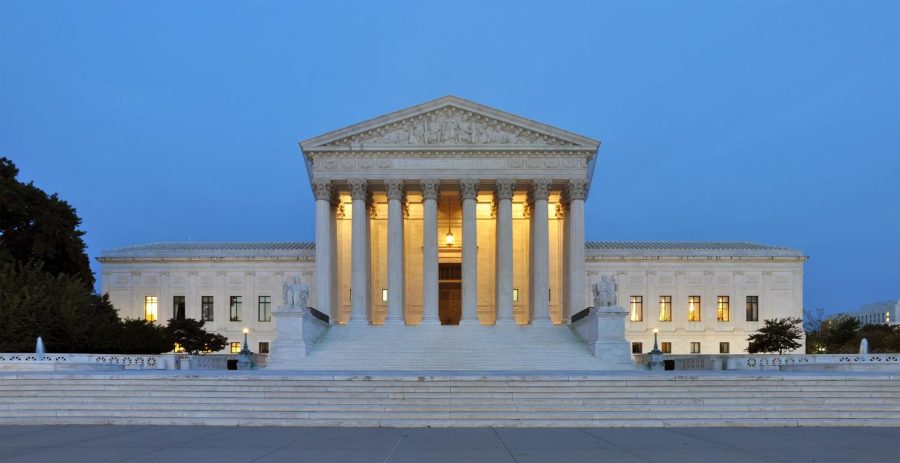Supreme Court term limits needed to preserve democracy
In the wake of the U.S. Supreme Court’s landmark decision to overturn Roe v. Wade, many nationwide are calling for term limits for Supreme Court Justices.
September 1, 2022
Following the United States Supreme Court’s landmark decision in Dobbs v. Jackson Women’s Health Organization, which overturned Roe v. Wade and stripped women of their constitutional protection to an abortion, a poll by Politico found that over two-thirds of Americans wanted significant reform to courts, specifically term limits for Justices.
Soon after the court’s decision, Democrats introduced a bill to Congress aimed at limiting Supreme Court Justice terms to 18 years. Though the bill is still in its early stages, Congress must pass it for the future stability of our democracy.
Unlimited terms were first established for Supreme Court Justices in Article II of the United States Constitution, which stated that unlimited terms were necessary to decrease politicization on the court and to allow Justices to do their jobs without interruption. However, as American society has changed substantially in the years since the Constitution was ratified; the rules governing the U.S. Supreme Court must also be updated to reflect the reality of life in modern America.
Since the 1700s, the average term length for a Supreme Court Justice has significantly increased, along with life expectancy, giving unproportional power to nine individuals in a way the founders could have never imagined. This increase in longevity has led to less turnover in appointments, which leads to a highly-politicized nomination process, judges who are out of touch with society and several other issues that have led to the court’s lowest approval rating in decades. The current state of affairs is unsustainable and legislators must create term limits before it is too late.
The main reason why unlimited terms were added to the U.S. Constitution was to decrease the politicization of the Supreme Court and allow it to make its decisions as an independent judiciary, which was separate from the influences of the executive and legislative branches. However, as the average Justice’s term is now longer than it has ever been, the exact opposite has happened. This growth in longevity and overall power of the Justices has contributed to the increasingly political nature of the confirmation process since there are no regular vacancies and justices can now be expected to serve on the court for several decades.
As a result, presidents are incentivized to appoint Justices to the court who have records that demonstrate they will rule in line with the president and the party’s ideology, as this would mean that that president’s legacy and views would live on long after their term as president ends. Acting in this manner is encouraged by our current system, yet proves extremely harmful for the United States, as it hampers the court, which is making the most important congressional decisions in the country.
Additionally, presidents appointing Justices at younger ages just to make sure that someone who shares their same ideology can be on the court for 50-plus years only further harms the
American people, as these Justices have less experience on smaller courts before having to make the jump to ruling on some of the biggest cases in the country. Another problem with such an action is that by the end of their decades-long terms, these Justices who were appointed at young ages end up being out of touch with the reality of the United States’ current situation.
Our society is changing all the time, and values that were in place 30 years ago when some of the current Justices were appointed to the Supreme Court are no longer appropriate today. However, it is extremely hard for individuals to completely change their developed values, which results in Justices trying to apply these outdated values to cases that deal with modern issues, such as affirmative action. Regular term limits would fix this issue by increasing turnover and having new and more in-touch Justices coming into the court every decade or so. Implementing this system would be extremely beneficial to the United States and would allow us to progress even further forward as a society.
However, no reform, especially not one on this scale, is without risks. For example, judges with limited terms may start considering post-judicial careers and opportunities in their rulings. This is even more true for judges on lower courts, which is why the reform should only be implemented on the Supreme Court, as this is the court which is making the most important decisions for the future of the country. However, this is a minor risk to take, especially when considering the future-altering benefits that would come with implementing term limits. The commission itself proposed a solution to this risk, saying that there could be a potential ban on positions that Justices could hold after retirement.
Our country is going through a period of great change;however, it is being held back by an increasingly politicized and out-of-touch Supreme Court, which is deciding on life-changing issues for Americans, such as Affirmative Action and abortion. The court’s current rulings on these issues, without turnover, further means that they will be a lot harder to overturn in the future, even as the views of Americans change.
Term limits would fix this issue and make the whole court move forward with the times. For example, each pick would be less intense due to the understanding that each president would get around two picks at the start of their presidency. The simple reality is that the Supreme Court must change, and introducing term limits is the first step to doing so.







